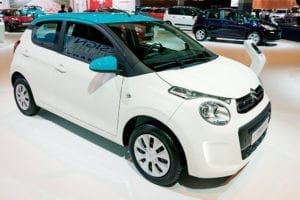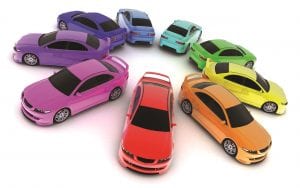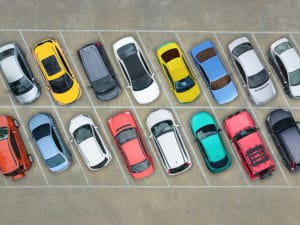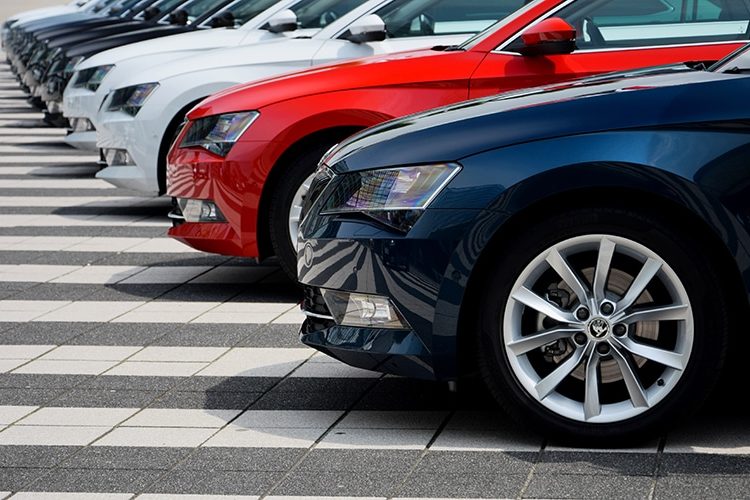By Cynthia Challener, CoatingsTech Contributing Writer
Car buyers around the world prefer neutral colors by a large margin and have done so many years. That trend is expected to persist for the next several years as well, although colors should make a small comeback.
Of all possible color choices, white predominates in the global vehicle market and holds a 38% share. The four neutral shades—white, black (19%), gray (15%), and silver (9%)—made their way onto 81% of vehicles produced in 2020, according to Axalta’s 68th Global Automotive Color Popularity Report. Meanwhile, colored shades such as blue, red, brown/beige, yellow/gold, and green each accounted for less than 10%: 7%, 5%, 3%, 2%, and 1%, respectively. These statistics are based on Axalta’s analysis of 2020 automotive build data and are an indicator of current market trends, notes Nancy Lockhart, global product manager of color at Axalta.
 Within the neutral shades, one shift of note identified by the Axalta report is the increase in popularity of gray, which is now perceived as being more modern and luxurious, at the expense of silver. PPG, in fact, forecasts that gray will remain a popular core color for automotive stylists moving forward, driven by the resurgence of concrete and stone materials and the on-going appeal of ceramic and metal tones, according to Misty Yeomans, PPG color styling manager, Americas. The gray palette will shift toward warmer hues with brown influences, while blue-inflected grays will retain their fashionability. The influence from nature will be apparent in silver stylings moving forward as well.
Within the neutral shades, one shift of note identified by the Axalta report is the increase in popularity of gray, which is now perceived as being more modern and luxurious, at the expense of silver. PPG, in fact, forecasts that gray will remain a popular core color for automotive stylists moving forward, driven by the resurgence of concrete and stone materials and the on-going appeal of ceramic and metal tones, according to Misty Yeomans, PPG color styling manager, Americas. The gray palette will shift toward warmer hues with brown influences, while blue-inflected grays will retain their fashionability. The influence from nature will be apparent in silver stylings moving forward as well.
“Warmer and more organic tones will further reflect current consumer tastes while also aligning with the highly compatible nature of very light tones, including whites, and with new radar and LiDAR technologies,” she says.
White remains the top color for not only due to consumer preferences, but also the move toward autonomous driving technologies. Within the white space, demand was up in Asia-Pacific market but slightly down in South America, according to PPG’s 2020 automotive color popularity report.
In North America, there was particularly strong growth in white metallics within the luxury car segment (21% to 38%). In addition to being highly compatible with emerging radar and LiDAR technologies that enable self-driving vehicles, white colors reflect consumers’ desire for refined simplicity and versatility in turbulent times, according to Yeomans.
“In addition to the pearl and metallic whites that are already widely popular, we anticipate a new dimension of white stylings in the automotive market that create a warm, sophisticated feel, such as creamy shades of ivory or bone-colored tints and ceramic effects,” she observes.
Potenial solutions for keeping cars cool and making them visible to LIDAR technology are based on combining organic pigments with NIR reflectors, such as inorganic pigments or aluminum, and avoiding carbon black, adds Bernhard Stengel-Rutkowski, senior global technical marketing manager at Clariant.
 Demand for black vehicles remained steady in 2020 compared with 2019, as the color remained a common choice due to its versatility and dramatic design potential, according to Yeomans.
Demand for black vehicles remained steady in 2020 compared with 2019, as the color remained a common choice due to its versatility and dramatic design potential, according to Yeomans.
“Effects and finishes that incorporate black tones allow for artistic reveals in the way color shifts, highlighting hidden undertones and adding a dramatic flair to the possibilities provided by the new pigments and finishes being developed within this color family,” she says.
Increasing interest in shades of blue was a key influence in developing Axalta’s 2019 Global Automotive Color of the Year, Sea Glass, which is a turquoise blue color. In PPG’s 2020 automotive color popularity report, blue accounted for a slightly higher percentage of vehicles than identified by Axalta—9%, which was up 1% from the previous year and reinforced the company’s 2019 automotive color forecast, which anticipated that sales of blue automobiles would increase over the next four years. Most of this growth occurred in Asia-Pacific markets; 10% of North American vehicles are already blue.
Yeomans says she believes the COVID-19 pandemic will further fuel global preference for the color.
“COVID-19 has consumers focusing on their desires and priorities,” she says. “Blue is an optimistic, comforting color that conveys trust, dependability, confidence, healing and hope. It’s also associated with nature, cleanliness and future-forward technology.”
She adds that more vivid or desaturated shades, deep-sea luxury tones and hues with a slight turquoise influence are expected to emerge, including digital-inspired aqua-blues that combine versatility with a sense of youthfulness and a fresh spirit. The emergence of the electric vehicle (EV) market will also drive growth in vibrant tones and interesting effects, such as color-shifting colors.
After two decades of focus on achromatic colors, Clariant has also observed a global color megatrend towards chromatic shades that stand out and add more color, according to Stengel-Rutkowski.
“Just like the auto industry that is currently reinventing itself and developing a more optimistic and sustainable image, these shades exhibit vibrant freshness and surprising color changes. These types of shades serve as an additional motivation for drivers to experiment with new forms of mobility themselves,” he notes.
Even so, there are some challenges to overcome, such as formulating bright yellow or red solid shades that hide well. Clariant offers “pseudosolids” formulations that contain aluminum flakes to afford solid-looking shades. Colored aluminum flakes and their combinations with bright mineral flakes supplemented by organic pigments, meanwhile, can be used to create formulations with attractive “color travel” properties, Stengel-Rutkowski says.
He adds that tinted clears can be used to produce very bright shades possessing “false-fluorescence” and are also being applied as highly transparent second layers to increase the depth of sparkle of the base layer or create a pearl effect, providing unique colors that support innovation in the automotive industry.
These trends are also reflected in the new 2020-2021 Automotive Color Trends collection from BASF. Called CODE-X, the collection includes new, reimagined whites, the darkest of jet blacks, and a variety of vibrant color spaces in-between and serves as inspiration to automotive designers for vehicles that will be on the road in three to five years, according to the company. Many have effects or textures, providing tactile as well as visual and emotional experiences.
The three key global colors are Social Camouflage, a grayish-green; Pundits Solution, a warmer beige; and Dark Seltzer, a medium-dark gray. As new thinking drives big transitions in the values around society, identity and progress, this collection represents the blend of the physical and digital worlds to stay hopeful and positive while coping with change, the company says.
For the European region, BASF’s automotive color collection includes soothing, calming colors with bold, new, distinct positions that bring the familiar together with the new and different, according to Mark Gutjahr, head of Automotive Color Design, EMEA at BASF. The warm and emotional colors in the Asia Pacific collection reflect a positive, flexible attitude for change, action and the future.
“Individuality is the trend in play here. We live for today and want to make the future better,” said Chiharu Matsuhara, head of design, Asia Pacific or BASF. In North America, the color collection leverages new colorant technologies that exhibit a greater sensitivity to the environment combined with grace and simplicity.
“It’s not unusual to presuppose technological stewardship dominates research, but it’s refreshing to see just how much the consumer is willing to forego traditional norms of beauty in order to satisfy the hunger for smart and responsible color designs,” says Paul Czornij, BASF’s head of design in the Americas.
The future landscape of automotive color continues to change as vehicle and consumer preferences evolve, Lockhart stresses. “Some key drivers for that evolution are more obvious than others, such as ecommerce, generational preferences, fashion styles and social currents. The mobility sector is very dynamic, and the evolution of technology and mobility platforms will change how people live,” she says. “Coatings technology has been challenged to not only be durable and aesthetically on trend, but also functional in the role it plays with autonomous vehicle driving sensors.”
There are also, however, environmental and economic requirements, as well as technical developments, that have considerable influence on the color palettes which will appear in the model years 2021 to 2023, according to Rutkowski.
“The car industry is currently going through a phase of transition, exploring alternatives to the traditional combustion engine, and trying out new ways of improving the safety and efficiency of transportation. These innovations can enhance both the creativity and feasibility of automotive color designs,” he concludes.
